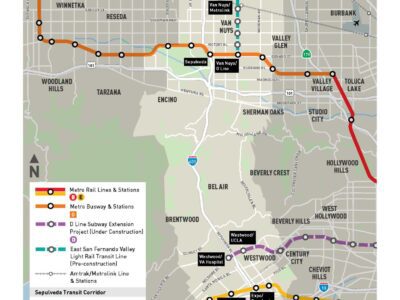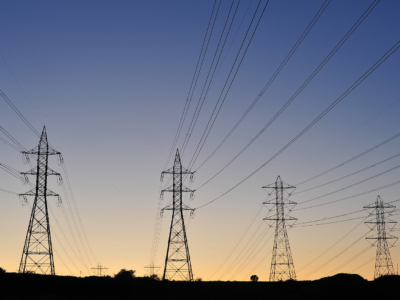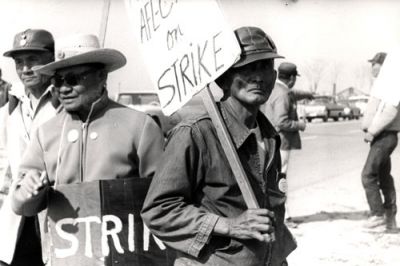How To Botch A CEQA Analysis
LA Metro’s draft EIR for the crucial Sepulveda Transit Corridor is thorough and careful, but it misses a key point: heavy rail is environmentally superior.

If you are from Los Angeles, you will get this.
Q: What’s the best thing about the 405?
A: Free parking.
The 405 is the highway that runs down the west side of metropolitan Los Angeles, connecting the San Fernando Valley to west Los Angeles, down through the South Bay and into Orange County. Even by Los Angeles standards, it’s a nightmare.
The trouble is that there is no real transit option. You can get across the Valley on rapid bus, and starting in 2028 (assuming that the Trump Administration doesn’t decide to destroy the Olympics, which it might), you will be able to get from downtown to the westside (including UCLA), but you cannot get from north to south.
Enter the Sepulveda Transit Corridor Project. The idea is to connect the Valley and the west side with transit, and it is obvious to all concerned what that transit should be: heavy rail from Sherman Oaks to UCLA, and then connecting to the D Line along Wilshire Boulevard. UCLA is the largest employer on the west side: if a rapid transit line from the Valley linked to the campus, the campus station would be the single busiest non-transfer station in the system.

So you would think that it be would something of a slam dunk to do it that way. You would be wrong.
Enter the Bel-Air Association, the group representing the owners of some of the most expensive real estate in the city, and thus the world. They don’t want Metro to tunnel under their community. How could it work, they argue?, forgetting that literally this is what happens everywhere there is a subway. Yes, Bel-Air is in the Hollywood Hills; no, that doesn’t matter. BART goes underneath San Francisco Bay; the New York subway goes under the East River.
Undeterred, the Bel-Air Association has a new idea: monorail!!
Literally. They want a monorail to go along the 405, and drop people off next to the freeway. Problem: that isn’t where the destinations are: UCLA is about a mile from the freeway. Dropping people off at an unpopulated freeway junction won’t do anything.
Undeterred, the Bel-Air Association has an addition: the Peoplemover!!
The idea is that passengers to UCLA and the rest of Westwood would get on the monorail – which, remember, would not be completely connected to the bus rapid transit in the Valley, then get off before the monorail gets to the westside, and take a people mover to the UCLA campus. Yes, really: that’s the plan.
The monorail plan is obviously ridiculous: the more changes and stops that passengers need to make, the more that ridership plummets. But Los Angeles Metro in its recently-released Draft EIR dutifully considered the monorail proposal, and dutifully found the obvious: ridership is so much higher under heavy rail that it is far better for the environment.
The heavy rail alternatives reduce CO2 emissions by roughly 60,000 metric tons a year, whereas the monorail manages less than half that. The heavy rail alternatives will similarly reduce nitrogen oxide pollution three times as much as the monorail. Analysis of particulate matter finds the same thing. These are huge differences, and they are not surprising. Taking 100,000+ cars off the 405 every day has enormous positive effects on air quality. In environmental terms this is the biggest difference between the alternatives.
Little wonder, then, that heavy rail in the Draft EIR is the “preferred alternative.” All well and good.
But then, for some reason, the Draft EIR states that the monorail is the “environmentally superior alternative”! How can this be? It appears to be a combination between misunderstanding CEQA and – perhaps – preparing for litigation.
CEQA Guideline § 15126.6 (e)(2) states that “[i]f the environmentally superior alternative is the “no project” alternative, the EIR shall also identify an environmentally superior alternative among the other alternatives.” Okay, great.
But the Draft EIR puts it this way: “The environmentally superior alternative is the alternative that would be expected to generate the fewest adverse environmental impacts.” In other words, for Metro, it can consider negatives but it cannot consider positives. That is not the law. That is especially the case because a few years ago, the Legislature enacted SB 743, which specifically says that in doing transportation analysis for CEQA, the touchstone is not “Levels Of Service” – congestion – but rather Vehicle Miles Travelled. If you use just raw congestion numbers, it incentivizes leapfrogging greenfield development that actually harms the environment.
In the long run, it shouldn’t matter, and perhaps that is LA Metro’s strategy. The project will have some significant and unmitigable impacts, and Metro will have to issue a Statement of Overriding Considerations. The environmental, transit, and ridership impacts of heavy rail are so far superior to monorail that the Draft EIR could not come out any other way. So perhaps the idea is to acknowledge the smallest initial impacts of monorail just so a reviewing court cannot possibly say that Metro was hiding the ball. There is ample case law to the effect that a lead agency need not adopt the “environmentally superior alternative.”
But this is the sort of thing that gives CEQA a bad name, and it is real. CEQA is a good statute that has been badly abused, and the sorts of reforms that the Legislature has enacted over the last few years has made it better. Perhaps, though, the problem isn’t CEQA, or even CEQA abuse: it is CEQA misinterpretation. After 9/11, many people complained about a firewall that prevented the FBI and the CIA from sharing counterintelligence information, and pundits screamed about taking the firewall down. But as it turns out, as the 9/11 report explained, there was never any firewall to begin with: it was just bad legal reasoning, and maybe the same thing is occurring here.
In any event, get in touch with Metro and urge it to adopt the preferred alternative and heavy rail. We don’t get a second chance at this, and we need to get it right.
Reader Comments
3 Replies to “How To Botch A CEQA Analysis”
Comments are closed.







Heavy rail all the way.
The Olympics is only 3 weeks. You make it seem like Trump can destroy it and thus destroy rapid transit when the issue is Los Angeles can destroy its own case for mass transit by picking the monorail. Please grow up.
Public transit, of course, is the environmental positive solution to congestion and “getting around” our beautiful city. However, the traveling public will not use it IF It’s Not Safe! No matter the alternative system! The safety issues must be resolved before any decisions, choices are made. A strong, effective system must be developed. Bring back Metro Police, a well equipped police system to ensure the public they are safe, first, then build the system.